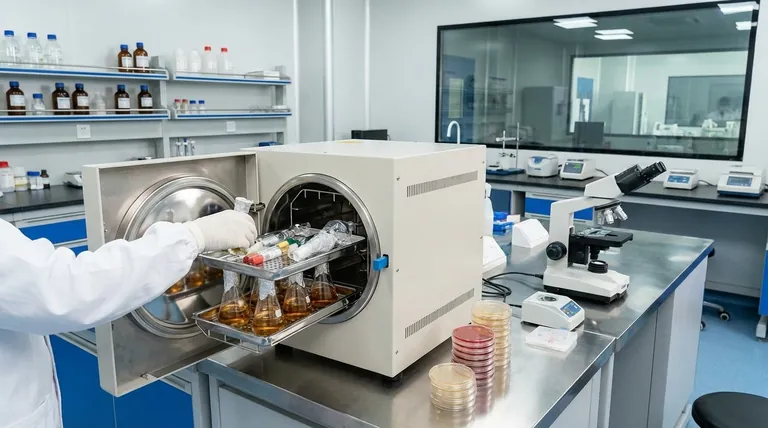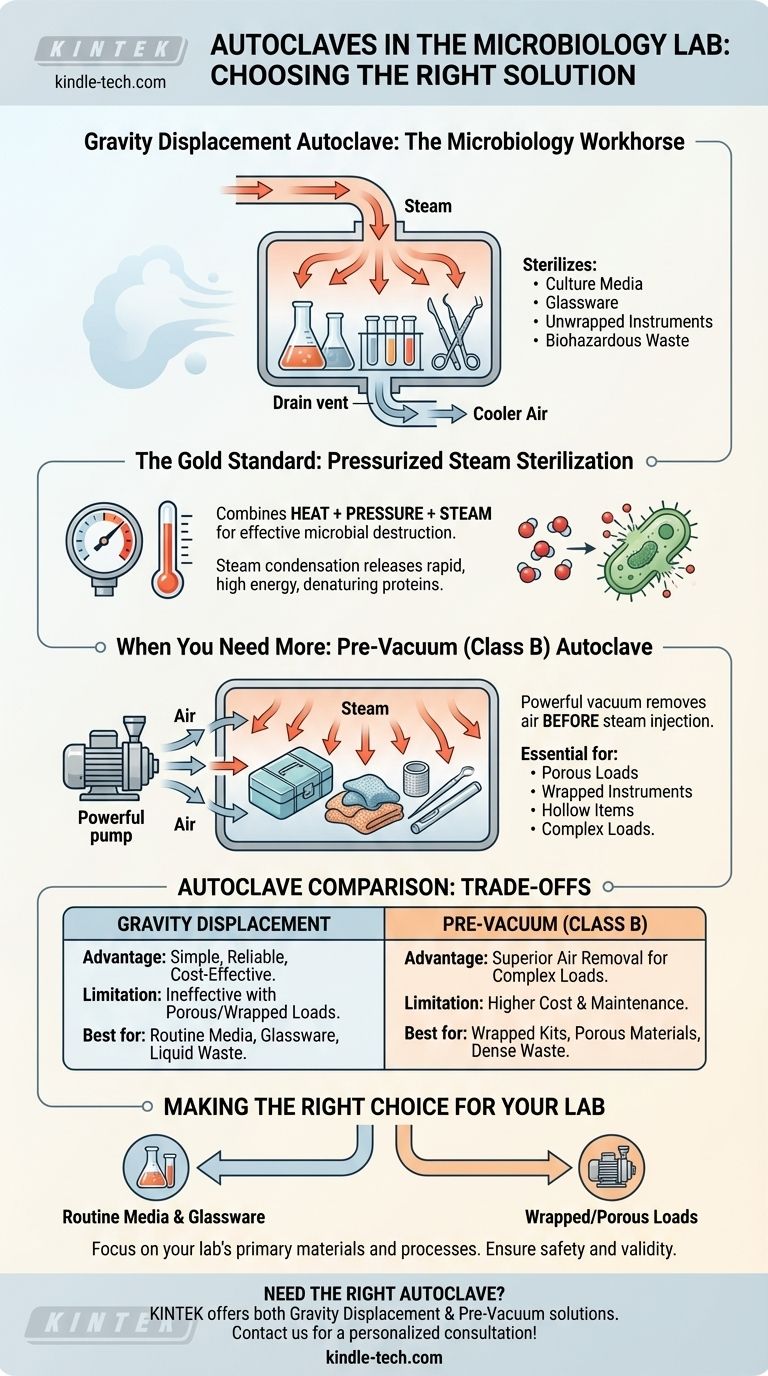In a standard microbiology lab, the most common type of autoclave used is the gravity displacement autoclave. This device is the workhorse for the essential tasks of sterilizing culture media, glassware, and decontaminating biohazardous waste. It uses pressurized, high-temperature steam to displace the cooler, ambient air within its chamber, ensuring all microorganisms are effectively destroyed.
The critical factor is not a specific brand, but the principle of operation. While gravity displacement autoclaves are the standard for most microbiology tasks like preparing media, more advanced pre-vacuum autoclaves are required for sterilizing complex or porous loads where air removal is a challenge.

The Core Principle: Why Pressurized Steam is the Gold Standard
The function of any autoclave is to create an environment that is lethal to all forms of microbial life, including resilient spores. It achieves this not through heat alone, but through the combination of heat, pressure, and steam.
How Sterilization Occurs
High-pressure steam is a far more effective method for transferring heat than dry air. When this steam condenses on cooler objects inside the chamber, it releases a massive amount of energy, rapidly heating surfaces and denaturing the essential proteins and enzymes that microorganisms need to survive.
The Standard for Microbiology
This method is ideal for microbiology because it is fast, highly effective, and leaves no toxic residue. It is essential for preparing sterile culture media, reagents, and instruments, and for safely decontaminating biohazardous materials before disposal.
The Workhorse: The Gravity Displacement Autoclave
For most routine microbiological work, the gravity displacement autoclave provides the perfect balance of simplicity, reliability, and effectiveness.
How It Works
This design works on a simple physical principle. Steam is piped into the chamber, and because it is less dense than cool air, it fills the chamber from the top down. The heavier, cooler air containing microorganisms is forced downwards and out through a drain vent.
Its Primary Applications
This model excels at sterilizing items where steam can easily penetrate all surfaces. Its primary uses in a microbiology lab include sterilizing liquid culture media, glassware (like flasks and test tubes), and unwrapped metal instruments. It is also used to decontaminate biohazardous waste.
When a More Advanced Autoclave is Needed
While the gravity displacement model is the standard, its effectiveness can be limited by the presence of trapped air. For more complex sterilization tasks, a different type of autoclave is required.
The Challenge of Air Pockets
Air is a poor conductor of heat and an obstacle to steam penetration. In porous materials (like surgical gowns or animal bedding) or hollow instruments, air can become trapped in pockets, preventing steam from reaching and sterilizing those surfaces.
The Pre-Vacuum (Class B) Solution
A pre-vacuum autoclave, also known as a Class B autoclave, solves this problem. Before introducing steam, it uses a powerful vacuum pump to actively remove air from the chamber. This ensures that when steam is injected, it immediately penetrates even the most complex, porous, or hollow loads, providing a much more reliable sterilization cycle for challenging items.
Understanding the Trade-offs
Choosing the right autoclave requires understanding the balance between capability, complexity, and cost for your specific laboratory needs.
Gravity Displacement: Simplicity vs. Limitation
The primary advantage of a gravity displacement autoclave is its simplicity and lower cost. It has fewer moving parts and is perfectly suited for the bulk of a microbiology lab's work. Its main limitation is its ineffectiveness with porous or wrapped loads, where trapped air can lead to sterilization failure.
Pre-Vacuum (Class B): Versatility vs. Complexity
A pre-vacuum autoclave offers superior versatility, capable of sterilizing virtually any type of lab equipment or waste. However, this performance comes with higher initial cost, increased complexity, and greater maintenance requirements due to the addition of a vacuum pump and more sophisticated controls.
Making the Right Choice for Your Lab
Your decision should be guided by the primary materials and processes your lab handles daily.
- If your primary focus is routine culture media preparation, glassware, and liquid waste decontamination: A standard gravity displacement autoclave is the most efficient and cost-effective choice.
- If your primary focus involves sterilizing wrapped instrument kits, porous materials, or large, dense biohazard bags: A pre-vacuum (Class B) autoclave is essential to guarantee complete air removal and ensure sterility.
Ultimately, understanding the principles of steam sterilization is the key to ensuring safety and validity in your microbiological work.
Summary Table:
| Autoclave Type | Primary Use in Microbiology | Key Advantage | Key Limitation |
|---|---|---|---|
| Gravity Displacement | Sterilizing culture media, glassware, liquid waste | Simple, reliable, cost-effective | Ineffective with porous/wrapped loads |
| Pre-Vacuum (Class B) | Sterilizing porous materials, wrapped instruments, dense waste | Superior air removal for complex loads | Higher cost and maintenance |
Need the right autoclave for your microbiology lab? KINTEK specializes in laboratory equipment and consumables, offering both gravity displacement and pre-vacuum autoclaves to meet your specific sterilization needs. Our experts can help you select the ideal model to ensure safety, efficiency, and compliance in your lab. Contact us today for a personalized consultation!
Visual Guide

Related Products
- Desktop Fast Laboratory Autoclave Sterilizer 35L 50L 90L for Lab Use
- Portable High Pressure Laboratory Autoclave Steam Sterilizer for Lab Use
- Portable Digital Display Automatic Laboratory Sterilizer Lab Autoclave for Sterilization Pressure
- Laboratory High Pressure Horizontal Autoclave Steam Sterilizer for Lab Use
- Desktop Fast Laboratory Autoclave Sterilizer 20L 24L for Lab Use
People Also Ask
- What is an autoclave used for in a lab? Achieve Total Sterilization for Lab Safety and Integrity
- What should be autoclaved in a lab? A Guide to Safe and Effective Sterilization
- What autoclave is used for sterilization? The Definitive Guide to Steam Sterilization
- What is the temperature of autoclave in microbiology lab? Achieve Sterile Conditions with 121°C
- What is an autoclave laboratory equipment? The Ultimate Guide to Steam Sterilization



















